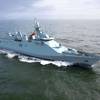Images of remotely piloted aircraft soaring over a naval fleet might seem like an ultramodern picture. But unmanned aircraft are nothing new to the Fleet Air Arm, which has provided remotely piloted targets for gunnery practice since 1953.
This started with the jet-powered Jindivik pilotless aircraft being used as a target, then for target towing before retirement in 1998.
Sea Sparrow missiles were tested by firing at Kalkara aircraft, the Jindivik’s successor.
Navy now has a different generation of remotely piloted aircraft in mind with fixed and rotary-wing maritime tactical unmanned air systems undergoing evaluation.
The first of these is the ScanEagle, a fixed wing, catapult-launched aircraft boasting interchangeable optical surveillance cameras and a passive search visual detection and ranging that uses image pixel comparison to find targets.
It has undergone sea trials and has also been flown from a land station on Christmas Island.
ScanEagle will deploy for extended sea trials aboard a frigate later this year with the new MH60R Seahawk.
A remotely piloted helicopter – the Camcopter S100 – will also undergo evaluation this year, with kits for two aircraft and ground stations due to arrive next month.
Navy opted to mount an auto identification and surveillance device alongside an MX10 high definition camera for the trials.
The two platforms are being used to develop an understanding of workforce requirements, organisational structures, performance specifications, tactics and procedures to maintain a permanent deployable maritime unmanned air system capability.
The ScanEagle and S100 Camcopter will enable Navy to investigate concepts of operations and inform future requirements.
Commander Fleet Air Arm Commodore Chris Smallhorn said it made sense to examine fixed and rotary wing systems during the trial.
“Fixed wing tends to have a higher endurance and is generally a more efficient machine in terms of payload and surface search area covered per flight hour,” he said.
“But it comes with launch and recovery challenges for a surface combatant-size vessel where space is always at a premium.
“Rotary wing has a shorter endurance but generally comes with greater and better payload opportunity, giving more options for multi-advanced sensor fits.
“The inherent vertical take-off and landing characteristic means it is capable of launch and recovery without the need for additional systems attached to the ship.
“Given the intent to operate both manned and unmanned systems from our surface combatants as required by given missions, the unmanned systems need to use the minimum space to ensure both aircraft may operate as a team or single capability brick.”
Commodore Smallhorn said no one should be wedded to the technology on offer because it was changing so quickly.
“To make any form of a determination in 2017 would be premature given what is likely to be on the table when we start going through more formal tendering processes,” he said.
The evaluation will look at how unmanned systems can team with manned combat or support helicopters.
“We are thinking carefully about which system and sensor fit the best teams with our manned platforms,” he said.
“The outcome may be a team greater than the sum of its parts. Having a system with a high endurance that could go and classify targets of interest while the manned aircraft is sitting on the deck might prove a better proposition for the combat helicopter.”
Aviation technicians of the Fleet Air Arm maintain and fly the system, with an aircrew officer the mission commander in a team of about five.
Commodore Smallhorn said Navy may form a separate squadron for the system in the future.
"It was also important to establish what information was needed from an unmanned system for combat decision-making.
“The easy approach would be to say ‘I want to interface everything into the ops room’,” he said.
“But how many people do you have in an ops room or ground control station to do all of that work?
“What information do you share? We don’t want to overwhelm the combat station with information.
“If you put a continuous, live, colour picture in the ops room, people will look at it. That may be good or bad depending what stage of a maritime mission you’re in.
“We must remember that as a system they are far from unmanned; people are on ground control stations and in operations rooms and the human engineering and information management aspect is critical.”













